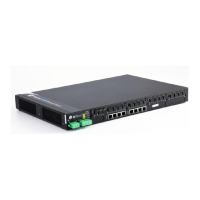MULTILINK ML3000 ETHERNET COMMUNICATIONS SWITCH – INSTRUCTION MANUAL 4–1
Multilink ML3000
Ethernet Communications Switch
Chapter 4: Operation
GE Energy
Oper ation
4.1 Functionality
4.1.1 Switching Functionality
The MultiLink ML3000 provides switched connectivity at Ethernet wire-speed. The ML3000
supports10/100 Mbps for copper media and 10 or 100 Mb separate traffic domains for
fiber ports to maximize bandwidth utilization and network performance. All ports can
communicate to other ports in a ML3000, but local traffic on a port will not consume any of
the bandwidth on any other port.
The ML3000 is a plug-and-play device. There is no software configuration necessary for
basic operation, installation, or maintenance. Optional half/full-duplex mode and 10 or
100 Mbps selection for the switched ports must be configured through software as per the
requirement. The internal functions of both are described below.
4.1.2 Filtering and Forwarding
Each time a packet arrives on one of the switched ports, the decision is taken to either filter
or to forward the packet. Packets whose source and destination addresses are on the
same port segment will be filtered, constraining them to that one port and relieving the
rest of the network from having to process them. A packet whose destination address is on
another port segment will be forwarded to the appropriate port, and will not be sent to the
other ports where it is not needed. Traffic needed for maintaining the un-interrupted
operation of the network (such as occasional multi-cast packets) are forwarded to all ports.
The ML3000 operates in the store-and-forward switching mode, which eliminates bad
packets and enables peak performance when there is heavy traffic on the network.
4.1.3 Address Learning
All ML3000 units have address table capacities of 4K node addresses suitable for use in
larger networks. They are self-learning, so as nodes are added, removed or moved from
one segment to another, the ML3000 automatically keeps up with node locations.

